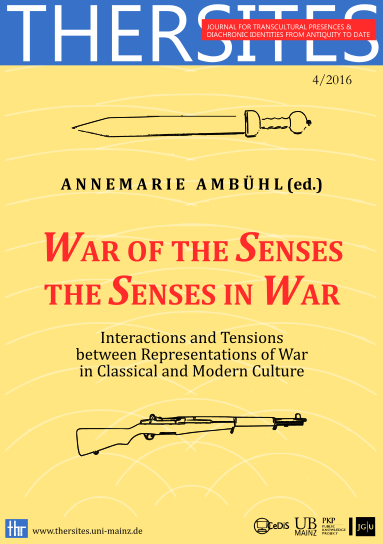Fantasie violente: il sogno ad occhi aperti in Omero e nel cinema
DOI:
https://doi.org/10.34679/thersites.vol4.38Keywords:
Homer, cinema, daydreams, violence, narratology, film theoryAbstract
Daydreams and visions are much used in fiction; filmmaking is perhaps the best way to represent them, thanks to its most powerful tool: editing. This paper focuses on a particular category of daydreams: violent phantasies. As a consequence of a public humiliation, often involving an erotic frustration, a character visualizes himself killing or harming his opponent, while in the real world such an action would be inappropriate. Taking cinema and visual rhetoric as a useful reference and with the aid of narratology, the paper analyses some scenes in Homer wherein the representation of violent phantasies is particularly interesting from this point of view.
Sogni ad occhi aperti e visioni sono molto usati nelle opere narrative, e il cinema trova nel montaggio uno dei mezzi più efficaci di rappresentare tali fenomeni. L’articolo prende in esame la particolare categoria delle fantasie violente: a seguito di un’umiliazione pubblica, che spesso ricopre una frustrazione erotica, un personaggio visualizza se stesso nell’atto di uccidere o ferire un avversario, mentre nella realtà un’iniziativa del genere risulterebbe inappropriata. L’articolo prende come riferimento cinema e retorica dell’immagine per analizzare, col supporto della narratologia, alcune scene omeriche dove la rappresentazione di fantasie violente è particolarmente interessante da questo punto di vista.
Downloads
Published
Issue
Section
License
Copyright (c) 2017 Pietro Verzina

This work is licensed under a Creative Commons Attribution-NonCommercial 4.0 International License.
Authors who publish with thersites agree to the following terms:
- Publishing in thersites is free of any charges.
- Authors retain copyright and grant the journal right of first publication.
- Users are allowed to read, download, copy, distribute, print, search, or link to the full texts of the articles, or use them for any other lawful purpose, without asking prior permission from the publisher or the author, so long as the original work is properly cited and is not used for commercial purposes. The journal is published under the Creative Commons Attribution 4.0 International License. More information about this license is available at https://creativecommons.org/licenses/by/4.0/.
- Authors are able to enter into separate, additional contractual arrangements for the non-exclusive distribution of the journal's published version of the work (e.g., post it to an institutional repository or publish it in a book), with an acknowledgement of its initial publication in this journal.
- Authors are permitted and encouraged to post their work online (e.g., in institutional repositories or on their website) as it can lead to productive exchanges, as well as earlier and greater citation of published work (See The Effect of Open Access).


